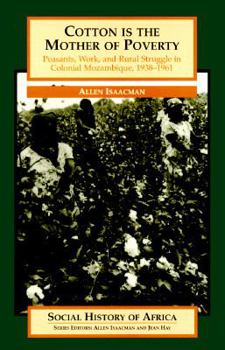Cotton Is the Mother of Poverty: Peasants, Work, and Rural Struggle in Colonial Mozambique, 1938-1961
Portuguese officials forced nearly a million African peasants to grow cotton in colonial Mozambique under a regime of coercion, brutality, and terror. The colonial state sought to control almost every aspect of peasant life: growers were told not only what they should produce, but where they should live, how they should organize their labor, and with whom they should trade. A privileged few managed to prosper under the cotton regime, but the great majority were impoverished, as cotton cultivation earned them next to nothing and exposed them to hardship and famine. Despite their efforts at control, the colonial state could only partially subordinate the rural population. This book explores the lives of Mozambique's cotton producers--their pain and suffering, their coping strategies, and their struggles to survive. Because the study is concerned above all else with the lived experiences of cotton growers, their stories figure prominently; the documentation for this book includes more than 160 interviews- with former cotton growers and their families, but also with African police and overseers, and with Portuguese settlers, merchants, missionaries, and officials. The producers' own stories, while acknowledging their bleak situation, provide evidence of agency, proactive struggle, and creative adaptation under difficult circumstances.
Format:Paperback
Language:English
ISBN:0435089781
ISBN13:9780435089788
Release Date:October 1995
Publisher:Heinemann Educational Books
Length:272 Pages
Weight:0.90 lbs.
Dimensions:0.6" x 6.0" x 9.0"
Customer Reviews
1 rating
Rural resistance to Colonial oppression
Published by Thriftbooks.com User , 24 years ago
To try and summarize this book in a few short lines would not do it justice. There are many aspects to this account of colonial regime in Mozambique whose sole reason for being was the extraction of raw resources from the land.The reader is introduced to the physical landscape of Mozambique, which in itself was as responsible for the success or failure of the Cotton Regime in the differing regions as any human agency. More land under cultivation meant production so the Regime sought to extend the planting of cotton to new regions, irrespective as to whether these places could sustain intensive agriculture. In the north, under-development and isolation helped local residents to resist the Regime more effectively than those in the south. It was in the south where Cotton Regime was to alter the social customs of the local population by forcing out migration of males.This exodus of men left the majority of work to be done by women and children. This started to blur the lines in regards to what had been gender specific jobs before the Regime. As Issacman says; women were perpetually on the front line in peasant struggles against the Cotton Regime.There are many things that I am leaving out in this review. Issacman goes into detail about how the Regime tried to control peasant access to their own fields to produce food for survival. These moves inevitably lead to food shortages as cotton fields were moved further away from villages in order to more easily control peasants. In this the Portugeuse were aided by local chiefs who would be rewards with people to work their own cotton fields.What I found to be one of the most interesting aspects of the book was Issacman's assertion that the peasants were not helpless victims of the regime. That they did indeed find ways to "cope", a term which is distinguished from "resisting" by the author. Coping strategies are seen to have the unintended affect of proping up the Regime. This can be seen as a strategy akin to a work slow-down in a contemporary labour environment. For the peasant growers in Mozambique these options were thus very limited, such as escaping the regime by fleeing to neighboring countries, holding back some of the labour, or by boycotting the system at strategic moments. Issacman saw these "Hidden" protests as the weapons of the weak.Thus, there were to be no great rebellions or revolts. The structual position of the cotton growers was not to change. These forms of resistance are seen by Issacman as a type of safety valve, which perpetuated the system of exploitation.






